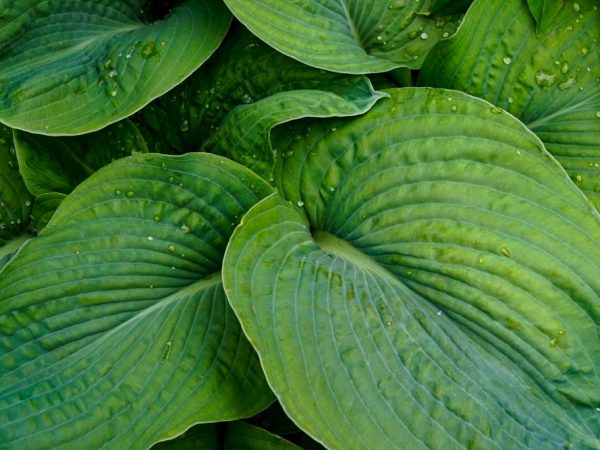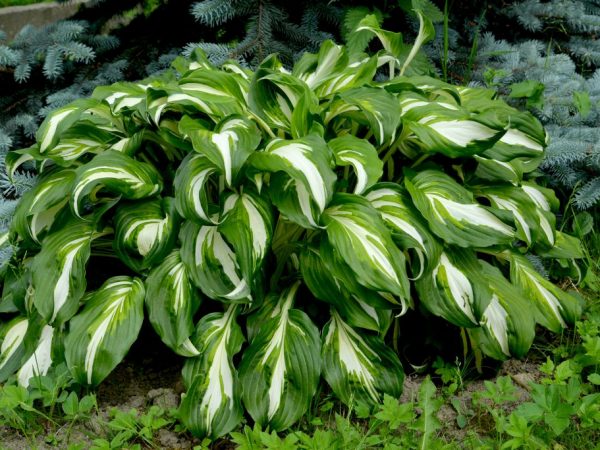Hosta care in autumn
Proper care of the host in the fall in the process of preparing it for winter is a guarantee that the plant will survive the cold season favorably and will delight the owner with its flowering next summer.

Hosta care in autumn
Features of autumn care
Caring for a hosta in the fall and preparing it for winter presupposes compliance with a number of mandatory rules.
Removing buds
In autumn, they begin to take care of the hosta by removing the preserved flowers. Hosta usually blooms in the second half of August, so buds remain on the shrub until the end of autumn. Among the initial measures for autumn care is the collection of buds left on the shrub after flowering. This will preserve the mineral nutrition of the plant for the winter, which, after the budding process, is spent on setting and ripening seeds.
Mulching
Mulching helps keep the plant warm. The natural protective layer is formed by the dried lower layer of foliage, but this is not enough. To create additional heat during the autumn care of the host, a layer of organic matter is laid out, which is suitable for sawdust, dried grass or peat mass.
Even grown in the open soil of the southern regions, where severe frosts rarely occur in winter, the hosta requires autumn preparation and shelter.
Before laying organic mulch, it is better to treat it with insecticidal agents that create protection against harmful insects and pathogenic microorganisms that cause bacterial infections. The tobacco dust added to the mulch will act as a deterrent against slugs and snails.
Autumn mulching with organic matter is at the same time a natural top dressing. The terms of leaving are different:
- for the middle lane - until October 15;
- for southern regions - until the end of October;
- for the Ural, Far Eastern and Siberian regions - until the end of September.
Top dressing
Usually, feeding a young plant after planting and engraftment is carried out in early summer, which ensures lush foliage growth. The last feeding of the root system of the plant is carried out in the process of pre-winter preparation, in the last days of August. Fertilizing procedures carried out later will not have time to prepare the shrub for wintering.
Suitable fertilizing complexes for caring for a host in autumn are those that contain phosphorus and potassium. These elements are absorbed by the root system of the bush, providing nutrition for future flowering.
Watering
During preparatory care in the fall, a moisture-loving hosta needs to be shed abundantly - to a depth of 0.5 m, avoiding falling on the foliage. The abundance and frequency of watering are reduced as the air temperature decreases, subsequently reducing to a minimum.
Care errors
In the process of leaving in the fall, it is not worth it:
- dry soil, because lack of moisture in the ground will adversely affect the quality of the root system;
- feed the shrub with nitrogen, because it leads to an intensive set of leaf mass, which will lead to an outflow of food needed for the winter;
- transplant before winter, because planting in a new place in the fall weakens the protective functions of the plant; planting should be carried out no later than August.
Pruning hosts before winter

Hosta needs pruning
Among the preparatory care in the fall is pruning the hosta for the winter season. It frees the plant from excess foliage on the lower tier, where slugs and snails prefer to settle, which, when warm, eat the foliage, not allowing the shrub to sprout fresh shoots.
Hosta needs pruning in the autumn, until the elastic foliage has time to turn into a slimy mass.
Pruning begins when the leaves turn yellow on the bush, dropping to the ground. By this time, all mineral nutrition had already gone into the roots and buds located in the root area. It is permissible to combine trimming the sheets with the pre-winter treatment of the plant with insecticidal agents against pests and bacterial infections.
It is recommended to remove the plant tops remaining after pruning a month before the expected onset of frost, because a delayed late procedure leads to freezing of exposed sections. Usually this period falls on the last week of October, in the middle lane - in the first half of November.
The foliage is removed by cutting off the growth points from above.
After pruning, no fertilizer is applied.
With a sudden onset of frost, pruning is not carried out, but soil is dug under the bushes, which makes it possible to create protection against pests and bacteria.
Shelter for the winter
Shelter for hosts before winter is necessary especially in the northern regions. Organic mulch acts as a shelter, and a covering material will become an additional tool.
Shelter works are planned by the hosts for warm calm weather, when the soil has dried up. Initially, mulch is made by mixing sawdust, old grass, brushwood and peat in equal proportions. The earth is scooped up under the bush, and the mixture with mulch is poured around the root base.
When the hosts are sheltered, the foliage is treated with insecticidal preparations for the winter.
The bush is covered with material. Along the perimeter, bricks or stones are laid on top of the shelter, which will fix the material and protect the plant from rodents.
Roofing felt and polyethylene, which provoke the formation of condensation, are unacceptable for shelter. The moisture that appears under the shelter causes the foliage to scatter and leads to the appearance of rot, which serves as a favorable environment for the development of fungal infections.
Suitable materials for sheltering hosts for the winter are agrofibre, spunbond and burlap.
Conclusion
Caring for hosts in the fall in preparation for winter includes measures for feeding shrubs, pruning and sheltering for the winter season using mulch and covering materials. If the plant is properly cared for, it will retain its appearance, and at the end of the cold season, it will begin to grow and bloom.


